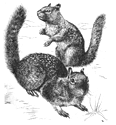Vertebrate Pest Conference Proceedings collection
Date of this Version
March 1976
Document Type
Article
Abstract
Deer and reforestation interact mainly during regeneration after wildfire or logging. In interior forests, browsing by mule deer often damages conifer seedlings planted on winter or transitional ranges. In the Douglas-fir region, numbers of black-tailed deer increase dramatically after forests are logged or burned, in response to improved forage supplies. Here, browsing on planted stock in clearcuts lowers forest productivity by reducing growth rates and occasionally contributes to plantation failures. Browsing damage can be controlled by fences or cages, but costs are prohibitive. Amelioration of damage by black-tailed deer could be achieved through long-range planning for concurrent deer and timber harvests, with hunting pressure directed to areas where logging promotes more deer. Thus, more deer can be made available to hunters and browsing damage to reforestation lessened. Such programs would require complete cooperation among resource managers and an intensive, well-planned effort to sell them to both customers and critics.

